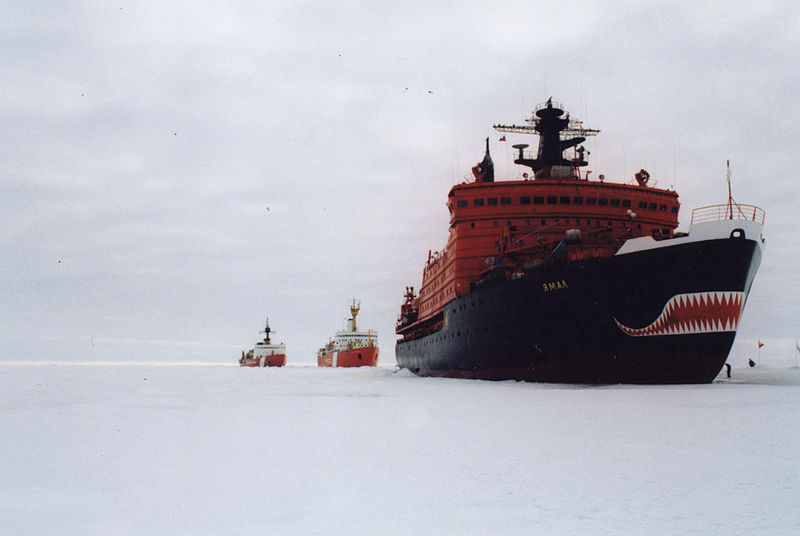REGULATIONS ON ICE
Polar Code, Set Of Proposed Arctic Shipping Rules, Could Go Into Force In 2016 Unfortunately The IMO Assumes Continued Global Warming While Ice cover is actually increasing.Updated 2/24/2016/ Updated 12/6/2016
EDITOR'S NOTE: 12/6/2016 The Polar Code has been adopted and enters into force in 2017
American Admiralty Books Safety & Privacy Policies (Attention EU Visitors , possible "cookie" encounter ahead)
 |
| The Russian YAMAL, CCG LOUIS ST. LAURENT,and the CGC POLAR SEA Russian, Canadian, and American Ice Breakers working together on August 1, 1994. Photo by LCDR Steve Wheeler, official DHS Photo (PD) |
Editor's Note: The International Maritime Organization (IMO) has developed a comprehensive shipping code for the High Arctic. The IMO anticipates that climate warming will continue and that the Arctic will open to more shipping. At the moment the polar regions lack a comprehensive international operational code which means each voyage in the region requires individual negotiations with insurers. By passing a universal code describing the ice capability of hulls and similar matters insurance rates and requirements should standardize and more traffic result. Our own thought is that regardless of warming, most of the traffic increase is destination cargoes related to oil exploration in the region, not real through traffic looking for a shorter route between the continents. There are signs that global warming has about run its course, if that holds water over the next several years neither through traffic nor oil exploration will be come any easier. The difficulty, expense , and danger of such operations have been the deterrent to expanded use of the High Arctic. In fact based on global temperature averages over the last few years the overall climate has not been warming and more ice, not less has been observable the last two winters in the Polar regions. Regardless a Polar IMO code is a good thing, though this one is not as comprehensive as we would like to see. The Huff Post has the story, a lead in and link are below.
By Balazs Koranyi
"TROMSOE, New international shipping regulations may soon to be agreed upon for the Arctic, where summer sea ice has shrunk by about two-thirds over three decades. However this year Arctic Sea Ice thickened and spread and Atlantic surface waters inversed and surface water temperatures fell. Yet discussions went forward as if the warming trend was assured.
Maritime nations especially those on the rim of the Arctic Ocean are close to a landmark deal on the Polar Code. The code is meant to improve safety, lead to lower insurance premiums and help the rise of traffic, industry insiders said. As we have previously explained we expect a rise in Arctic destination traffic, logistic support of Arctic industrial activities, but real increase in through traffic.
About a tenth of the world's undiscovered oil, and nearly a third of its undiscovered gas is believed to be under Arctic waters. The Northern Sea Route along Russia's edge if not ice clogged can reduce the sailing distance between Asian ports and Northern Europe by 40 percent during a limited sailing season.
A draft code is thought to be finalized, possibly last winter by members of the International Maritime Organization (IMO) and may go into force by 2016, ending years of delays. But will there be any through traffic to care?
"TROMSOE, New international shipping regulations may soon to be agreed upon for the Arctic, where summer sea ice has shrunk by about two-thirds over three decades. However this year Arctic Sea Ice thickened and spread and Atlantic surface waters inversed and surface water temperatures fell. Yet discussions went forward as if the warming trend was assured.
Maritime nations especially those on the rim of the Arctic Ocean are close to a landmark deal on the Polar Code. The code is meant to improve safety, lead to lower insurance premiums and help the rise of traffic, industry insiders said. As we have previously explained we expect a rise in Arctic destination traffic, logistic support of Arctic industrial activities, but real increase in through traffic.
About a tenth of the world's undiscovered oil, and nearly a third of its undiscovered gas is believed to be under Arctic waters. The Northern Sea Route along Russia's edge if not ice clogged can reduce the sailing distance between Asian ports and Northern Europe by 40 percent during a limited sailing season.
A draft code is thought to be finalized, possibly last winter by members of the International Maritime Organization (IMO) and may go into force by 2016, ending years of delays. But will there be any through traffic to care?
Link to A related Huffington Post Story: IMO CODE
http://www.imo.org/en/MediaCentre/PressBriefings/Pages/38-nmsc94polar.aspx#.WEXRhPkrLtQ
No comments:
Post a Comment